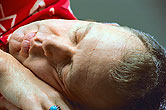
MONDAY, May 14 (HealthDay News) — Sleepwalkers on TV and in movies are often played for drama or laughs, but the phenomenon is surprisingly common in American households, a large, new study suggests.
In what they said is the first research in three decades on sleepwalking prevalence in the United States, scientists from Stanford University School of Medicine found that about 3.6 percent of U.S. adults are prone to sleepwalking, a higher proportion than previously thought. Nocturnal wandering is also tied to certain psychiatric conditions such as depression, anxiety and obsessive-compulsive disorder.
“It’s probably more common than we realize, which doesn’t surprise me,” said Dr. B. Tucker Woodson, professor and chief of the division of sleep medicine at Medical College of Wisconsin in Milwaukee, who wasn’t involved in the study. “As clinicians we often see the cases in which it’s a problem, so if the occasional sleepwalking episode is not causing any problems, it tends not to be something people seek medical attention for.”
The study is published May 15 in the journal Neurology.
Study author Dr. Maurice Ohayon, a professor of psychiatry and behavioral sciences at Stanford, and his colleagues interviewed about 19,000 people aged 18 and older from 15 states, questioning them about their sleeping habits, general health, medications taken and mental disorders. Those who reported sleepwalking were asked about the frequency, duration, family history and any inappropriate or potentially dangerous behaviors during sleep.
Nearly 30 percent of participants reported having sleepwalked at least once in their lifetime, while nearly one-third of the 3.6 percent who had done so within the previous year said they sleepwalked twice or more each month. Family history was a strong predictor, with about 30 percent of those who sleepwalked at least once in the previous year having family members who also experienced the disorder.
“When you have one episode of sleepwalking per month at minimum, you are disturbed by the disorder, no doubt,” Ohayon said. “More than once a month is a lot of episodes in a year. It could be harmful for them … because they don’t have the normal reactions. So it could be a big accident coming, but happily that’s very rare.”
Participants who had experienced depression or obsessive-compulsive disorder were 3.5 times and 3.9 times more likely to sleepwalk, respectively, than people without the conditions, the study found. Those who took antidepressants known as SSRIs, or selective serotonin reuptake inhibitors, were three times more likely to sleepwalk twice a month or more.
Ohayon cautioned that it’s not clear whether the psychiatric conditions themselves or drugs used to treat them were responsible for the heightened sleepwalking incidence.
“An association doesn’t mean you have a causality link,” he said. “It means at maximum, the SSRIs are triggering sleepwalking, but are not the cause. That is clear.”
Participants using over-the-counter sleeping pills had a higher chance of reporting sleepwalking at least twice a month, while gender and race weren’t associated with the disorder and it seemed to lessen with age.
Ohayon and Woodson agreed that longitudinal research needs to be done that can examine the long-term factors contributing to sleepwalking, which wasn’t possible in this cross-sectional study.
“Sleepwalking is a really interesting phenomenon in that it represents the brain in different states — part of the brain, in a sense, is awake, and part is asleep,” Woodson said. “We’re learning that other disorders may have similar brain activity . . . with mixed states of wake and sleep. I don’t think we understand them all that well. Most are not associated with serious medical consequences, but obviously sometimes they can be.”
More information
The U.S. National Library of Medicine has more about sleepwalking.

